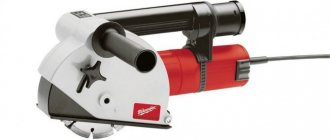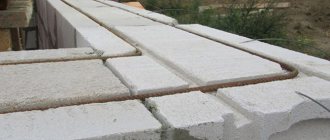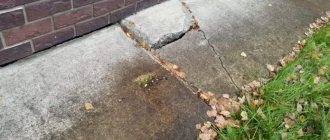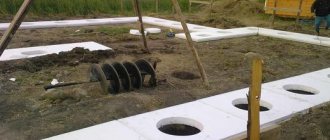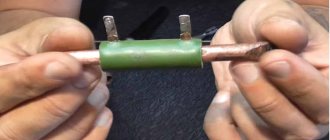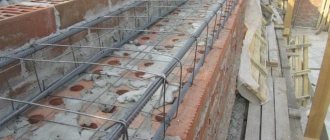Aerated concrete is currently very popular in private construction. First of all, this is due to its lightness and large volume of blocks. The second advantage is the foam structure of the material - thanks to it, it perfectly retains heat indoors. Communications are laid inside the finished building, and some of them, especially electrical wiring, are almost always installed in the wall. To make a groove, you need a special tool, and a wall chaser is best for this. In this material we will understand what a wall chaser for aerated concrete is, what types of this device there are, and how to make a wall chaser for aerated concrete with your own hands.
Types and features of furrow machines
There are two types of such tools: electric and manual. Using an electric device, making grooves is much more convenient and faster, but due to its high price and narrow focus, it is almost never bought for home needs. It makes sense for a person who is professionally involved in electrical installation work to purchase an electric furrower. To cut grooves yourself, you usually use a manual wall chaser for aerated concrete, the cost of which is several times lower.
Features of manual wall chasers
Such a device, as mentioned above, costs much less than an electric one, but working with it requires more time and effort. In addition, this wall chaser is intended only for aerated concrete blocks - it cannot cope with brick, reinforced concrete and other hard materials. Its advantage is noiselessness and low dust formation.
Features of electric wall chasers
Using this equipment, it is possible to make electrical grooves not only in aerated concrete, but also in materials such as reinforced concrete, brick and others with high hardness.
In addition, a vacuum cleaner can be connected to the electric furrower, which will prevent a layer of dust from settling on surrounding objects.
The disadvantage of such devices is the loud noise they make during operation. This has a harmful effect on the worker’s hearing, as well as on the nervous system of neighbors if gating is carried out in an apartment building. When working with an electric wall chaser, you must wear special clothing and also use protective equipment - a respirator and goggles.
Types of wall chasers for aerated concrete
All devices for cutting aerated concrete are classified into electric and manual. If the question of acquiring the first is obvious: purchase or rent, the second can be done independently. This will take no more than one hour.
Manual
Aerated concrete differs from ordinary concrete in its low density, which is inherent in it due to its cellular structure. This feature allows grooves to be made to the desired size using a simple, hand-held tool. The price of a manual wall chaser is 500-1,000 rubles. or an hour of time spent making it yourself.
Electric (aerated concrete cutter for drill)
Electrical tools that can be used for cutting aerated concrete include several options:
- An electric wall chaser is a special tool equipped with two parallel disks that set the depth and width of the groove. In one pass it leaves 2 strips, the gap between which is easily knocked out with a punch blade or manually. Price: from 2,500 rub. The disadvantage is a lot of dust, the advantage is the ability to adjust the depth and width of the disks.
- Manual circular saw, grinder - the disadvantage of working with tools is the likelihood of injury. When processing non-uniform material (passing a masonry seam), it may break off. A lot of dust.
- Hammer, drill - holes are drilled along the intended line, at a distance of 15-20 mm. The gaps between them are broken out with a chisel or a hammer drill blade. The advantage is less dust than when working with an electric wall chaser or grinder. The downside is the uneven trajectory of the furrows.
- The final option is considered the simplest and most effective way of slicing a gas block. A special milling attachment for a drill has the advantages of all of the above methods: little dust, straight lines, low price. If you have a homemade machine-bed, the speed is no different from working with an electric wall chaser. The only condition is the use of a powerful tool; constant lateral load on the electrical equipment gearbox can cause its breakdown.
Design and types of manual furrowers
This equipment is a piece of metal pipe to which a metal arc is welded, which acts as a cutting element, and two pressing handles. More expensive models are equipped with a diamond tip.
There are two types of manual wall chasers:
- For gating horizontal surfaces.
- For working with vertical surfaces.
There are no fundamental differences between these devices. They differ from each other only in that the clamping handles are fixed at different angles, and the base tubes are bent differently. The difference in the device is due to the goal of correctly distributing the forces applied to the apparatus when gating both vertical walls and horizontal surfaces.
An example of the operation of a horizontal wall chaser in the video:
How to operate a manual wall chaser
Cutting grooves with such a furrow maker is carried out in the following order:
- Mark the surface so that the groove is level.
- Place the cutting part of the device at the beginning of the marking.
- With your right hand, grab the clamping handle, which is located directly above the cutting element, and with your left hand, grab the handle remote from it.
- Slowly pull the device with your left hand along the markings, while simultaneously pressing the other handle with your right hand.
A manual furrower, although it is not very expensive, does not have to be bought in a store. For a small amount of work, a manual wall chaser for aerated concrete can be done independently without much effort.
You can also make a wall chaser for aerated concrete, which can be used in construction. Video example:
What is a wall chaser for aerated concrete?
When renovating apartments, homeowners take a new approach to the placement of utility networks and various communications:
- water supply pipes;
- heating lines;
- power cables;
- sewer risers.
Wall cutter for aerated concrete
It is understandable that apartment owners want to place communications inside the walls and thereby improve the appearance of the premises. The technology for hidden placement of highways involves the creation of special grooves. In the vocabulary of professional builders, such channels are called grooves. For their production, a gas silicate wall chaser is used. The tool began to be used relatively recently. Before its appearance, equipment was used for chiselling grooves that created vibration during operation and negatively affected the strength of building structures:
- a bolt or chisel that was struck with a hammer. The process of creating the grooves was slow and required considerable effort;
- pneumatic hammer. The tool created increased noise and significant vibration. A lot of dust was also present during the formation of the channel;
- industrial hammer drill. During the formation of cavities, vibration negatively affected the strength of concrete and caused the formation of cracks.
The use of these types of equipment required significant physical effort and was characterized by reduced productivity and increased labor intensity. Increased concentration of dust, significant noise and vibration caused a lot of inconvenience. The outdated equipment was replaced by a wall chaser for aerated concrete - a hand-held tool that has many advantages:
- reduces the duration of laying channels in walls;
- reduces the labor intensity of construction operations for gating;
- allows you to provide the necessary channel geometry in various building materials;
- provides the ability to adjust the width and depth of the cavity being formed;
- removes dust from the treated area, reducing dust concentration;
- forms a channel of the correct shape with constant dimensions along the length.
We advise you to study Mimo 4g lte antenna with your own hands
Industrial wall chaser for aerated concrete
For one-time work, there is no need to purchase an industrial wall cutter for aerated concrete, which is quite expensive. There is a good solution - you can assemble a wall chaser from an angle grinder with your own hands. Drawings are not needed for this modernization, because the design is simple. Using available materials, you can expand the technical capabilities of home tools equipped with an aspiration system.
The use of a self-made tool ensures:
- reducing the cost of plastering the groove due to the neat shape of the channel. The resulting groove does not require an increased amount of plaster;
- the ability to cut grooves in building materials with increased hardness. In this case, two cuts are performed at once in one pass.
After processing, all that remains is to remove the cut building material located between the cuts, and you can begin laying communications.
Making a manual furrow machine
Let's move on to the question of how to make a wall chaser for aerated concrete with your own hands. To make a simple device, you will need a piece of durable metal pipe, the diameter of which should be approximately 20 mm. Then, measuring 50-60 mm from one of the edges, use a grinder to make a cut, holding the tool at an angle of 45°. When this is done, bend the top of the pipe at an acute angle. A homemade wall chaser designed for aerated concrete is ready. Most of it serves as a handle, and the second is a cutting element for the foam block.
To make a more complex tool, you will have to spend a lot of effort. In addition, you should have a welding machine at your disposal.
This furrow maker is done as follows:
- Weld two pieces of metal pipe (reinforcement) in a perpendicular position at the central points. For the part that will serve as a handle, it is better to take a thicker piece - it will be more convenient to use such a device.
- The length of the piece from which the working part will be made should be 10-15 cm, and the diameter should be 25-30 mm.
- You need to make a cut at an acute angle from one or both edges of the pipe - this will be the working surface.
- Weld the short side of the tube to the base. The corners of the work element must be on the outside.
To facilitate the assembly of the tool and not make mistakes during manufacture, it is advisable to make a drawing before starting work, indicating the angles and dimensions on it.
Visual step-by-step manufacturing instructions on video:
Preparation and proportions of expanded clay concrete for floor screed
Expanded clay concrete is one of the types of lightweight concrete, most often it is used for insulation or in the construction of buildings with lightweight walls. According to their intended purpose, this material is divided into heat-insulating, heat-insulating-structural and structural (the most durable). Despite the fact that expanded clay concrete is most in demand in the form of ready-made blocks, it is also possible to independently produce this material to create a floor screed or for other tasks.
Let's consider the composition and ratio of the components of expanded clay concrete, depending on its purpose. If we talk about a concrete screed, then the inclusion of expanded clay concrete in its composition, instead of crushed stone or gravel, makes the concrete slab lighter and increases its thermal insulation characteristics. The ingredients must have the correct proportion in the expanded clay concrete composition so that the floor screed does not crack and has sufficient strength.
The optimal ratio of cement, sand and expanded clay ranges from 1:2:5 to 1:3:6, depending on the expanded clay fraction, cement brand, quality and moisture content of the sand. At the same time, the recommended grade of Portland cement is not lower than 400
It is important to understand that the strength of expanded clay as a filler is significantly lower than the strength of crushed stone, so low grade cement cannot be used here
We advise you to study the melting point of lead
You can also use expanded clay concrete for blocks or fill monolithic walls with liquid expanded clay concrete mortar. To do this, it is recommended to take the following ratio: 1 part cement, 1 part sand and 10-12 parts expanded clay with a fraction of up to 20 mm. Mortar walls with this proportion will have sufficient strength, good thermal conductivity and durability.
The only question that remains is how to mix a good solution? The first step is to fill the expanded clay with cement laitance so that all the granules are completely wetted. The composition of the milk is 2 parts water to 1 part cement. Each builder chooses how to mix expanded clay himself, based on the available funds. After the expanded clay is fully impregnated with milk, the main components are added to it in calculated proportions. For the foundation, expanded clay concrete is used only in the form of ready-made factory blocks; independent preparation is associated with too high risks.
www.avtobeton.ru
Is it possible to make an electric wall chaser yourself?
If desired, such a device can be made at home on the basis of a simple grinder. However, most masters do not recommend doing this for the following reasons:
- The productivity of a tool made from a grinder is quite low; in addition, it has all the disadvantages of factory-made equipment (it makes a lot of noise when cutting blocks and produces a large amount of dust). It must be used together with a powerful vacuum cleaner, otherwise later you will spend more time cleaning the room than making the grooves.
- If attaching two disks to a single axle fails, the groove will have to be cut in two stages, which will generate more dust and increase time.
- It is impossible to adjust the gap between the disks on a homemade wall chaser with high accuracy, as a result of which the groove may turn out uneven.
- A furrow machine assembled by a non-specialist can be dangerous, since established standards and safety precautions are rarely observed during its manufacture.
Based on this, we can say that if large-scale work is not planned, it is advisable to make do with a manual furrow maker.
But, as already mentioned, it is only suitable for aerated concrete blocks - it is not capable of stronger material.
Self-production of an electric wall chaser
If you still need an electric furrower, but don’t have the money to buy one, you can try to make one yourself. A simple grinder is used as a base. Additional materials you will need are a pair of diamond discs for aerated concrete that have the same diameter and an additional fastening nut.
The tool is assembled in two steps:
- Install the first disc and tighten it tightly with the nut.
- Then install the second one on top of the first cutting wheel and also carefully secure it with a nut.
When assembling a wall chaser yourself, you need to be very careful. If the length of the threaded part is not enough to securely fix two cutting wheels, it is better not to use such a tool.
Criterias of choice
When purchasing a tool, you should pay attention to such parameters as:
Power. The most important factor that determines the performance of a device. Varies from 900 W to 3 kW. The main rule is that the power must correspond to the diameter of the disk and the work performed. It is advisable that the device have a power reserve - this will protect the motor from overheating.
Disc diameter. Determines the maximum depth of the groove to be made.
Disk rotation speed. It determines how high quality the cut will be.
We advise you to study the Formula of mechanical power - average and instantaneous power
Adjusting the distance between discs. For laying wires, a groove 1-2 cm wide is enough. If the task is to install a pipe into the wall, this figure should be much larger. Therefore, the adjustment range must be selected according to the purpose of the work.
Weight
The lighter the device, the less your hand gets tired (it is especially important to take into account the weight when working on ceilings). At the same time, it is possible to reduce the weight of the tool only simultaneously with a decrease in power.
Noise level
The sound of discs cutting concrete is usually very loud. It is advisable that the overall volume is not increased too much by the noise of the electric motor. You can check this indicator by starting the engine at idle speed.
Vibration. There is no information about this characteristic in the instructions. The degree of vibration can only be assessed experimentally or based on feedback from tool owners.
Auxiliary functionality: soft start; protection against overload, jamming, accidental activation; automatic rotation speed control; vibration damping system; maintaining cut depth.
How to ensure dust removal?
A homemade electric furrow machine, although it has lower performance than a factory-made tool, produces no less dust when grooving. To save the walls of the room and the objects in it from dust, you need to attach a special casing to the equipment, which will provide an outlet for connecting a vacuum cleaner. Such casings are commercially available, but you can make this device at home, saving money.
To make the casing, you can use a metal sheet or a simple plastic bottle. The most important thing is to equip the protection with a tube to which the vacuum cleaner will be connected. It should be located at the top of the protective device and its connection to the suction hose should be tight. Thus, dust generated during operation will be immediately drawn into the vacuum cleaner.
